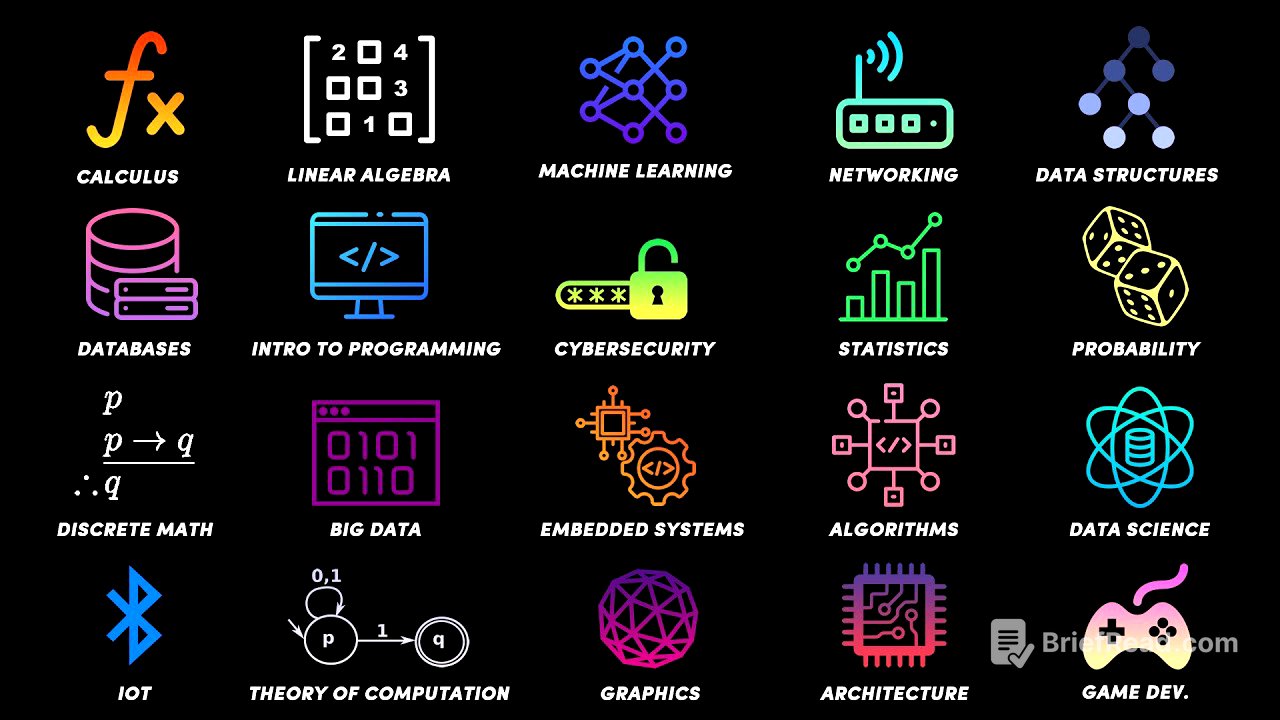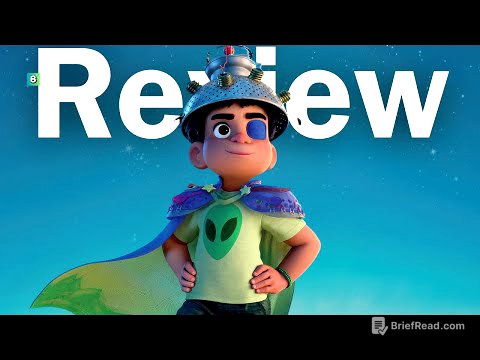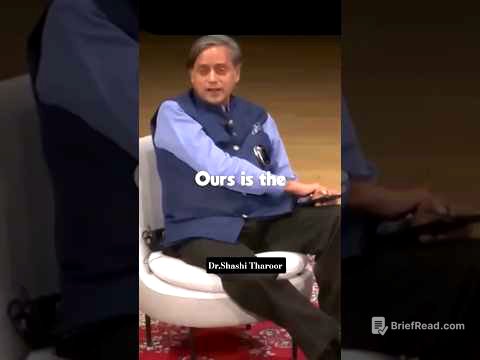TLDR;
This video provides a concise overview of essential computer science courses, highlighting their core concepts, practical applications, and the skills they impart. It covers topics ranging from introductory programming and data structures to advanced subjects like machine learning, cybersecurity, and big data, offering insights into the theoretical foundations and real-world applications of each field.
- Introductory programming teaches basic coding, problem-solving, and computational thinking.
- Discrete Mathematics focuses on the pure logic of computers, teaching the language of computers.
- Machine learning teaches students how to work with or create AI.
Intro to Programming [0:00]
Introductory programming courses teach the fundamentals of coding, problem-solving, and computational thinking, typically using languages like Java, C++, or Python. The curriculum includes basic syntax, data structures, variables, input/output operations, conditionals, loops, functions, and debugging techniques. Students learn to translate logic into code and break down complex problems into smaller, manageable steps, focusing on efficient and scalable code. Key topics include time complexity, data structures (arrays, linked lists, stacks, queues, trees, graphs), and fundamental algorithms (sorting, searching, recursion).
Algorithms & Data Structures [0:40]
A cornerstone in computer science is having programs work as efficiently as possible. Key topics covered in this course are time complexity or how long does it take for a program to run measured in big O, big omega or big theta, data structures such as arrays, linked lists, stacks and cues, trees or graphs. Also fundamental algorithms such as sorting algorithms such as quicksort, merge sort and bubble sort. searching algorithms such as binary search and dystra's algorithm and recursion such as the tower of Hanoi, the Fibonacci sequence and Y Combinator. This course mainly teaches how to write efficient and scalable code which is key to many coding interviews.
Discrete Mathematics [1:29]
Discrete Mathematics explores the foundations of computer science, focusing on countable, whole, and discrete items, excluding decimals or complex numbers. Key topics include formal logic, predicate logic, mathematical proofs (direct proof, proof by contradiction, proof by cases, mathematical induction), and rigid mathematical definitions. The course also covers functions (subjective, injective, and bijective), elementary graph theory, set theory and operations (union, intersection, complement), number theory (modular arithmetic, encryption), and basic combinatorics. This course enables students to learn the language of computers and think more logically and computationally.
Computer Architecture [2:45]
Computer Architecture bridges the gap between hardware and software, teaching how a CPU processes instructions, manages memory and input/output, and translates high-level code into machine language. The course covers Boolean algebra, logic gates, combinational and sequential circuits, and assembly language programming. Students explore CPU design (arithmetic logic units), memory hierarchy (SRAM vs. DRAM), GPU architecture, and input/output systems (storage devices). The C programming language is utilized, and the basics of quantum computing may be introduced. Skills gained include operating system development, visualizing data flows from CPUs, and working with embedded systems.
Calculus [3:39]
Calculus is a math class focused on rates of change and finding the area and volume of irregular shapes, divided into differential and integral calculus. Differential calculus covers limits and derivatives, teaching techniques like the power rule, product rule, quotient rule, and chain rule. Integral calculus deals with finding the volume or area under a curve, using integration techniques such as substitution and integration by parts. The course also covers series convergence/divergence and the basics of differential equations. Calculus is useful for machine learning, graphics, physics engines, and tracking algorithm growth and speed.
Linear Algebra [4:43]
Linear Algebra focuses on vectors, matrices, and linear transformations, essential for computer science, physics, and engineering majors. Vectors represent direction and magnitude, while matrices are grids of numbers used to solve complex problems by performing math on multiple numbers simultaneously. Linear transformations involve transposing 2D planes while preserving straight lines and transforming around a central point. Linear algebra is applied in computer graphics, 3D space, machine learning, and algorithms like Google's PageRank.
Databases [5:32]
Databases teaches students how to interact with, manage, and structure data, covering relational databases with tables, rows, and keys. Students learn SQL (structured query language) to select, insert, update, and delete entries in a database, along with database design principles like binary trees and hash tables. The course also introduces NoSQL databases like Redis or MongoDB and tools such as MySQL, SQL Lite, Firebase, and AWS. Learning about databases is crucial for creating records for businesses, managing website backends, and data science.
Networking [6:13]
Networking explores how devices communicate over the internet and the structure of networks. Students learn about protocols like HTTP, TCP/IP, and DNS, analyze packets with tools like Wireshark, and study different network types (WAN, LAN, VPNs) and topologies (STAR, mesh, bus). The course also covers the OSI model and working with cloud platforms such as AWS and Azure. A computer networking class provides tools for cybersecurity, cloud engineering, backend development, and DevOps.
Theory of Computation [6:47]
Theory of Computation explores the theoretical and philosophical aspects of computer science, examining the limits of what is computable. Topics include finite state automata (diagramming machine actions based on inputs), regular languages, and Turing machines (theoretical computers with looping and conditional capabilities). The course dives into algorithmic complexity and open questions like P versus NP, and the halting problem. It teaches students the limits of computing, security, and hardware design.
Probability & Statistics [7:46]
Probability and Statistics focuses on quantifying and analyzing data to make data-driven decisions. Students learn the fundamentals of probability, basic set theory, and Bayes' theorem (conditional probability). The course covers probability distributions (normal distribution), data visualization tools (histograms, box plots, scatter plots), and statistical concepts such as the central limit theorem, confidence intervals, p-values, and effect sizes. Students use software like Pandas, SciPy, Matplotlib, the R programming language, and Microsoft Excel. This class is crucial for computer science majors interested in machine learning, algorithms, or data science.
Machine Learning [8:46]
Machine Learning teaches students how to work with or create AI, focusing on how computers can learn from given information. The course covers neural networks, back propagation, activation functions, natural language processing, and deep learning. Python is the dominant language, with libraries like Scikit-learn, TensorFlow, and PyTorch. Prerequisites typically include other programming courses, linear algebra, and calculus. A class in machine learning prepares computer science majors for AI careers and applications in healthcare (diagnosis) and finance (fraud detection).
Cybersecurity [9:32]
Cybersecurity equips students with the tools to protect computer systems from digital attacks, covering vulnerability defenses and white hat hacking. Students learn about cyber attack types (DOS, phishing, cross-sight scripting) and defenses (firewalls, encryption), along with legal and ethical issues of privacy and disclosure. The course covers threat modeling like the STRIDE model and tools such as Metasploit and Nmap for penetration testing. Cybersecurity knowledge includes both computer-related security flaws and non-computer risks like social engineering. This class is important for computer science majors due to high demand in healthcare, government, and finance.
Computer Graphics & Game Development [10:30]
Computer Graphics and Game Development teaches students how to build and develop 2D and 3D games, often as an elective. Students learn to use game engines such as Godot, Unity, and Unreal, along with graphics APIs like OpenGL. Key gaming concepts include game loops, physics (collision detection), and AI (pathfinding, behavior trees). The course also involves 3D modeling tools like Blender and Maya, and animation techniques such as skeletal rigging, key framing, and motion capture. This class is beneficial for careers in the gaming industry, filmmaking, virtual/augmented reality, and medical simulations.
Embedded Systems & Internet of Things (IoT) [11:14]
Embedded Systems and the Internet of Things (IoT) combines hardware and software to design and program embedded systems like microcontrollers and sensors. Students learn about IoT architectures such as edge computing and cloud integration, along with wireless protocols like Wi-Fi and Bluetooth. Tools like Arduino or PlatformIO are utilized. This field is in growing demand with applications in smart homes, wearables, IoT development, and robotics.
Big Data & Data Science [11:43]
Big Data and Data Science is an interdisciplinary blend of statistics, programming, and machine learning, used to derive insights from data. The goal is for students to learn the data science pipeline: collection, cleaning, analysis, visualization, and storytelling. The course primarily uses Python, R, and SQL, along with big data tools such as Spark and Hadoop. This course provides students with the skills to seek high-demand jobs in tech, finance, and healthcare.









